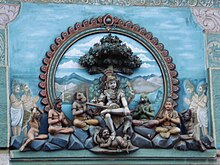|
Dakshinamurti
Dakshinamurti (Sanskrit: दक्षिणामूर्ति, romanized: Dakṣiṇāmūrti)[1] is an aspect of the Hindu god Shiva as a guru (teacher). He is regarded to be the personification of the supreme or the ultimate awareness, understanding, and knowledge.[2] Dakshinamurti represents Shiva as a teacher of yoga, music, and wisdom, offering an exposition of the Shastras.[3] He is worshipped as the god of wisdom and meditation.[4] MeaningDakshinamurti literally means 'one who is facing south (dakṣiṇa)' in Sanskrit. According to another school of thought 'Dakshinya' means Karuna in Sanskrit or kindness (benevolence). So this manifestation of Shiva is a benevolent teacher who accords wisdom to seekers of salvation. [5] In most of the Shiva temples, the stone image of Dakshinamurti is installed, facing south, on the southern circumambulatory path around the sanctum sanctorum. Depiction In his aspect as Jnana Dakshinamurti, Shiva is generally shown with four arms. He is depicted seated under a banyan tree, facing the south. Shiva is seated upon a deer-throne and surrounded by sages who are receiving his instruction.[6] He is shown as seated with his right foot on mythical apasmara (a demon which in Hindu mythology, is the personification of ignorance) and his left foot lies folded on his lap. Wild animals are sometimes depicted surrounding him. In his upper arms, he holds a snake or rosary or both in one hand and a flame in the other; while in his lower right hand is shown in vyakhyanamudra, his lower left hand holds a bundle of kusha grass or the scriptures. The index finger of his right hand is bent and touches the tip of his thumb. The other three fingers are stretched apart. This symbolic hand gesture or mudra is the Gnana Mudra (or Jnana Mudra or Jana Mudra), a symbol of knowledge and wisdom. Sometimes, this hand is in the Abhaya Mudra, a posture of assurance and blessing. In Melakadambur the statue of the Dakshinamurti appears seated on a bull under a banyan tree with a hole extending from one ear to the other.[7][8] Dakshinamurti is portrayed as a powerful form brimming with ever-flowing bliss and supreme joy while being in the yogic state of abstract meditation. Variations of this iconic representation include Veenadhara Dakshinamurti (holding a Veena) and Rishabharudha Dakshinamurti (mounted on a Rishabha - the bull). Significance Indian tradition accords a special reverence to the guru or the spiritual teacher. Dakshinamurti is regarded as the ultimate guru, the embodiment of knowledge and the destroyer of ignorance (as represented by the demon being crushed under the feet of the deity). The Jnana Mudra is interpreted in this way:- The thumb denotes the god and the index finger denotes the man. The other three fingers stand for the three congenital impurities of man viz. arrogance, illusion and bad deeds of the past births. When man detaches himself from these impurities, he reaches God. Another interpretation is that the other three fingers denote the three states of life: Jagruti (Fully awake through senses and mind), Swapna (Sleep state - When the mind is awake) and Sushupti (True-self - When the senses and mind go into soul - Atma). The Abhaya Mudra, a gesture with the hand lifted above thigh with palm facing out, fingers pointing, is interpreted as his grace upon his students. The rosary or the snake signifies tantric knowledge. The fire represents illumination, removing the darkness of ignorance. Temples Even though the icon of Dakshinamurti is installed in every Shiva temple, there are only a few temples where Dakshinamurti is the chief deity.
HymnsMany mantras are dedicated to Dakshinamurti. Dakshinamurti Gayatri Mantra
The Dakshinamurti Stotra by Adi Shankara is a laudatory hymn dedicated to this form of Shiva.
I salute Śrī Dakṣiṇāmūrti, the Young Guru, who teaches the knowledge of Brahman through silence, who is surrounded by disciples, who are themselves ṛṣis and scholars in the Vedas. (I worship Śrī Dakṣiṇāmūrti), who is the teacher of teachers, whose hand is held in the sign of knowledge (cin-mudrā), whose nature is fullness, who reveals in himself, and who is ever silent.[12] YogadakshinamurtiYoga Dakshinamurti is an aspect of Shiva as a guru (teacher) of yoga. RepresentationIn his aspect as Yoga Dakshinamurti, Shiva is generally represented in any of the two styles described as under: - He is represented sitting in padmasana (lotus position) posture, engrossed in dhyana (meditation). He is shown as having four arms. His four arms are depicted in different ways. In the upper right hand he holds his trident (trishula); he carries a bowl of human skull in his upper left hand; the lower right hand is shown in chinmudra; and the lower left hand is raised to his chest. In another representation, he is shown as sitting under a banyan tree. His one leg rests on the ground, while the other is on his thigh, with the help of a Yogapatta. His four arms are shown in different ways. He carries an akshamala in his upper right hand; the upper left hand is shown as carrying fire; the lower right hand is depicted in dhyanamudra and the lower left hand is shown in abhayamudra (gesture of fearlessness). Below his seat, two deer are shown kneeling, and a cobra wound around his right arm looks towards him. References
External linksWikimedia Commons has media related to Dakshinamurthy. |
||||||||||||||||||||||||||||||||||||




